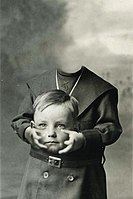Victorian headless portrait
- View a machine-translated version of the Russian article.
- Machine translation, like DeepL or Google Translate, is a useful starting point for translations, but translators must revise errors as necessary and confirm that the translation is accurate, rather than simply copy-pasting machine-translated text into the English Wikipedia.
- Consider adding a topic to this template: there are already 906 articles in the main category, and specifying
|topic=will aid in categorization. - Do not translate text that appears unreliable or low-quality. If possible, verify the text with references provided in the foreign-language article.
- You must provide copyright attribution in the edit summary accompanying your translation by providing an interlanguage link to the source of your translation. A model attribution edit summary is
Content in this edit is translated from the existing Russian Wikipedia article at [[:ru:Викторианский безголовый портрет]]; see its history for attribution. - You may also add the template
{{Translated|ru|Викторианский безголовый портрет}}to the talk page. - For more guidance, see Wikipedia:Translation.

Victorian headless portraits were a fad in Britain in the late 19th century. In the photographs, the model's head appears separated from the body; often the sitter holds it in their own hands.[1] Although this genre is called headless portraiture, it is the head that is always present in the photograph, and the body may be absent.

An early example of the genre is photographer Oscar Gustave Rejlander's Head of St. John the Baptist in a Charger, a print made by combining two different negatives.[2] The photograph dates from somewhen between 1855 and 1860. Photographer Henry Peach Robinson, described Reilander's insistence on finding a model for John the Baptist saying that "Rejlander saw his head on the shoulders of a gentleman in the town. …The curious thing is, that he did not so much see the modern gentleman as always the picture which the head suggested. It was some months before the artist ventured to ask the model to lend his head … and years before he obtained his consent."[3]
Many later photographers created similar images of men and women with severed heads, depicted held in their hands, laid on a platter or held aloft by the hair. Often in the other hand, the sitter carries the weapon of their own murder. The demand for such photographs was so high that many Victorian photographers openly advertised this particular type of photography.
The most prolific photographer in this genre was British photographer Samuel Kay Balbirnie, who ran advertisements in the Brighton Daily News offering "HEADLESS PHOTOGRAPHS - Ladies and Gentlemen taken showing their heads floating in the air or in their laps."[4]
Gallery
-
 Unknown photographer, 1890. Headless boy portrait.
Unknown photographer, 1890. Headless boy portrait. -
 Charles William Allen (1818-1889), Canterbury. Headless portrait, 1880s.
Charles William Allen (1818-1889), Canterbury. Headless portrait, 1880s. -
 Unknown photographer, UK. Headless woman, 1900.
Unknown photographer, UK. Headless woman, 1900. -
 Unknown photographer (France). A bearded man holds his severed head in his hand, 1899.
Unknown photographer (France). A bearded man holds his severed head in his hand, 1899. -
 William Robert Bowles (1861-1918). Servant serving his head on a plate, circa 1900
William Robert Bowles (1861-1918). Servant serving his head on a plate, circa 1900
References
- ^ Fineman, Mia; Art (U.S.), National Gallery of; Houston, Museum of Fine Arts (2012). Faking it: Manipulated Photography Before Photoshop. Metropolitan Museum of Art. p. 105. ISBN 978-1-58839-473-6. Retrieved 10 December 2020.
- ^ Roberts, Pam (2000). PhotoHistorica: Landmarks in Photography : Rare Images from the Collection of the Royal Photographic Society. Artisan. p. 177. ISBN 978-1-57965-169-5. Retrieved 11 December 2020.
- ^ Robinson, H. P. (1895). Picture-Making Photography (4th ed.). London: Hazell, Watson and Viney Ltd. p. 55. Retrieved 10 December 2020.
- ^ "Brighton Photographers". www.photohistory-sussex.co.uk. Retrieved 10 December 2020.
- v
- t
- e

















